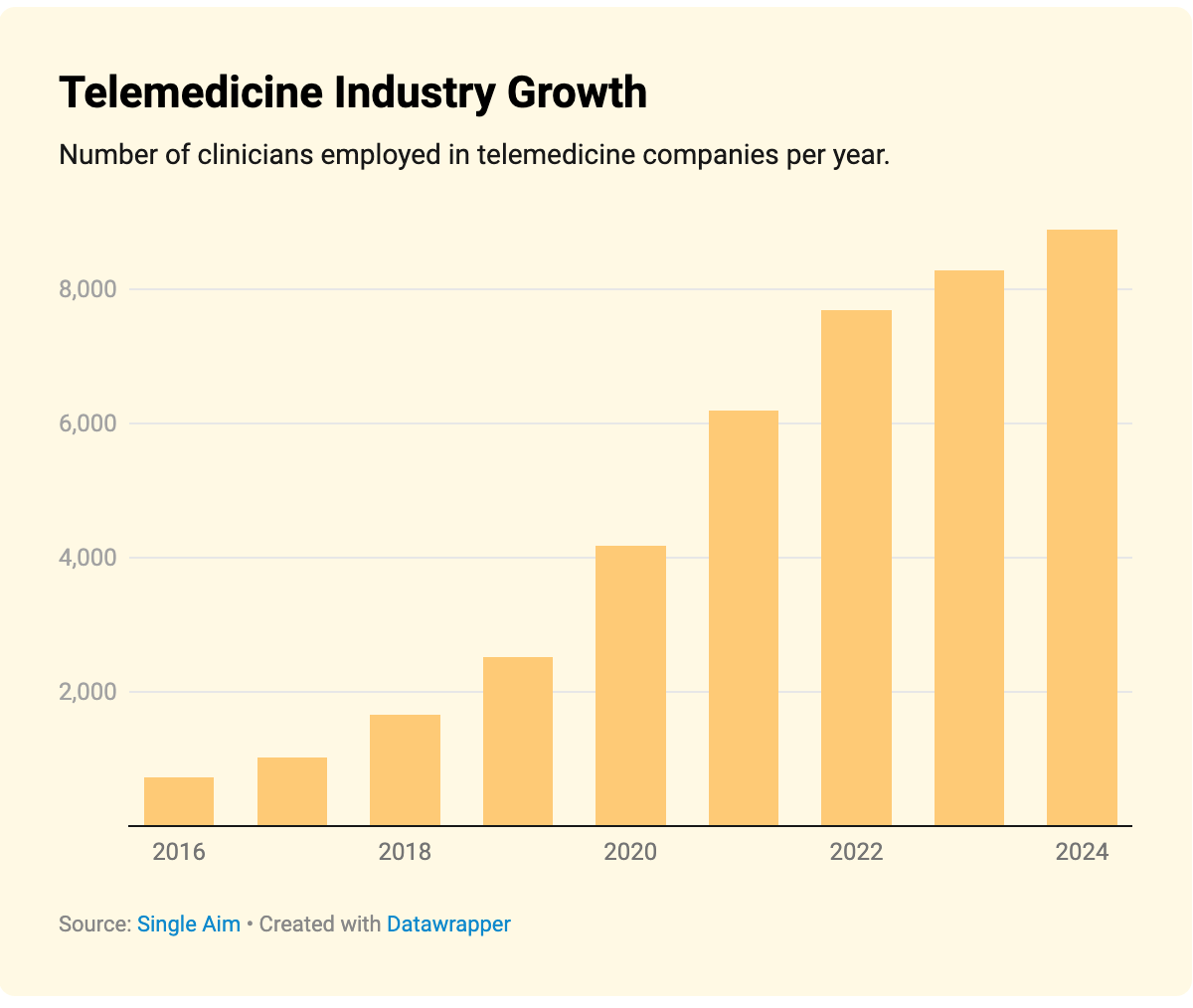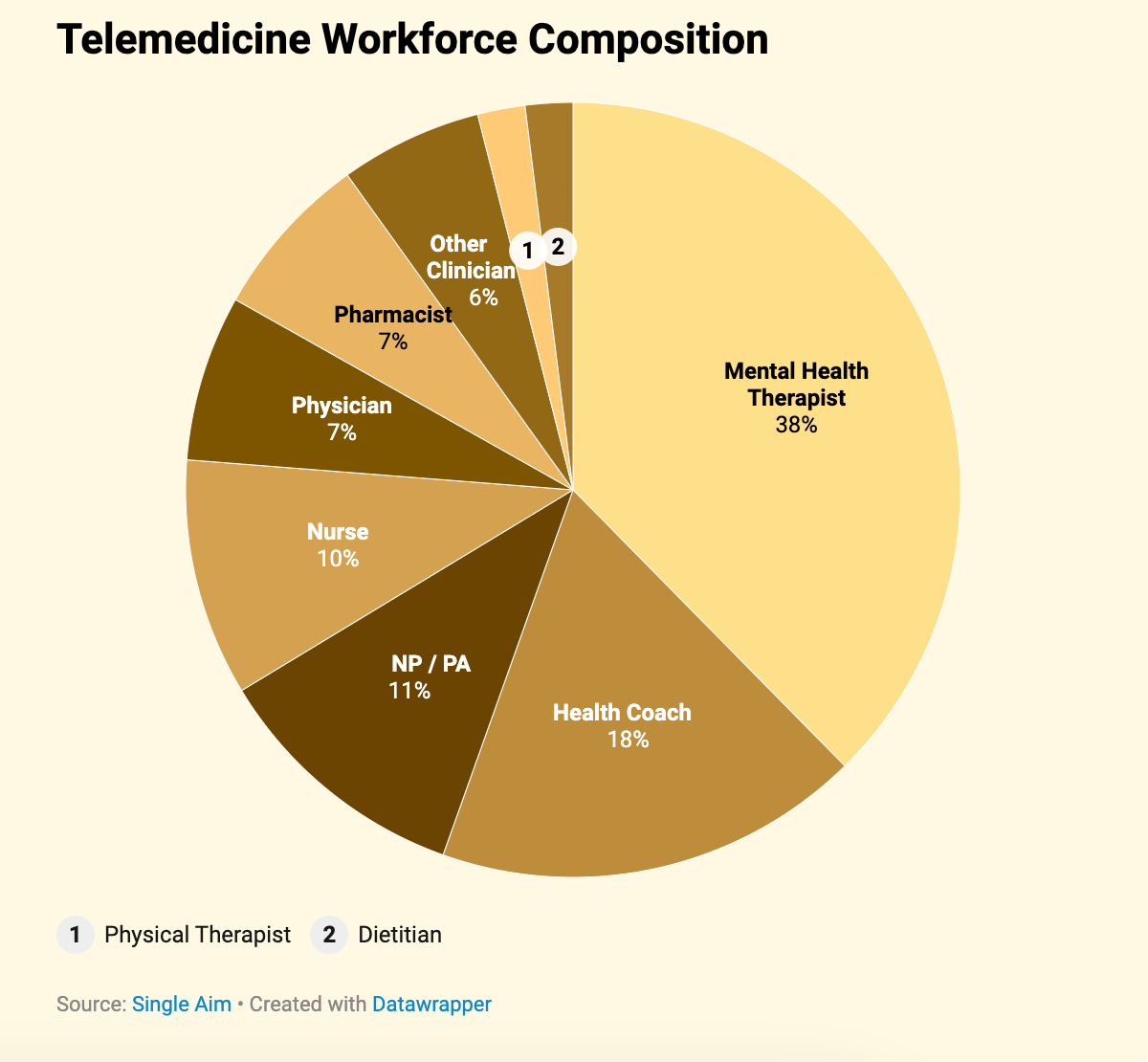Telehealth isn’t a new concept—in fact, 35% of hospitals had a telehealth option as early as 2010—but it wasn’t until 2020 that it became a preferred and popular way of receiving care. Before the COVID-19 pandemic brought in-person everything to a halt, most patients called the nursing line if they needed something after hours, or waited days (or weeks) for an appointment. If you had an appointment, you had to physically go to the doctor’s office, urgent care, or emergency room to receive care.
Since 2020, though, telemedicine has exploded.

To meet that demand, overall telemedicine employment has grown 1121% since 2016, according to SingleAim. While the rate of growth has slowed in recent years, it’s no longer a niche service as it was pre-pandemic. Patients can now access digital records, make appointments, request prescription refills, and speak with a healthcare provider without ever stepping foot in a doctor’s office.
Telemedicine appointments increased by 154% from 2020-2022. Now, patients expect telehealth options to be a part of their care. Whether that’s attending therapy or consult appointments over Zoom, chatting back-and-forth with providers over a messaging service, or calling with a question, patients are seeking out more immediate care using the technology they know and use every day.
What powers these telehealth options? Increasingly, health care organizations employ contractors to take point on these virtual interactions.
A Growth Model Built to Scale with Contractors
Many of these telehealth companies favor an MSO, or “business in a box” model of growth, unlike traditional clinics that hire salaried or full-time employees. The most well-known behavioral health telemedicine services like Headway, Alma, SonderMind, and Grow Therapy, for example, follow this model. Writes Chris Turitzin for SingleAim, “The MSO model has economic advantages for the company: clinicians bear the risk of their time being unutilized, and, in many cases, marketing is left up to the clinician. These are big advantages that allow MSO companies to scale faster.”
Notably, these companies run on 1099 providers rather than hiring full-time.
Every industry, not just telehealth, is seeing a push-pull between in-person and remote services. Increasingly, providers want to work remotely—while only 4% of nurse practitioner jobs right now are remote-friendly, more than 50% of LinkedIn searches in that role are looking for a remote job opening, according to SingleAim.

And many telemedicine clinicians use multiple platforms to advertise their services, in the same way that many contractor-based drivers take calls from both Uber and from Lyft. These providers are looking for more flexibility in an industry known for long hours and demanding patients—and serving as a contractor on a digital health platform is a way to do it.
Patients seek out this kind of care, too, with 60% of respondents to a McKinsey survey citing convenience and satisfaction as primary reasons they plan to continue using telehealth, even when it is no longer necessary. This seems to vary by sub-vertical, with 62% of mental health patients choosing telehealth for their recent appointment, compared to 20% for a primary care visit.

Writes Jenny Cordina for McKinsey, “Traditional providers…may risk losing market share over time as a result of patients’ initial visit and downstream care decisions. What’s more, as healthcare reimbursement continues to move toward value, virtual-delivery options could become a strategic differentiator that helps providers better manage cost. Most important, virtual care can offer an opportunity to improve outcomes for patients meaningfully by delivering timely care to those who might otherwise delay it or who live in areas with provider shortages.”
Behavioral Health Goes Virtual
The winner of the telehealth race? Behavioral health platforms like Grow Therapy, Charlie Health, Alma, and Talkiatry. Mental health demand has surged post-pandemic, with the vertical growing 63% since 2020. This makes sense: A doctor can only do so much without physically examining a sick patient, but a therapist or psychiatrist can make a world of difference without needing to be physically present.
Says Turitzin, “Over half of all telemedicine clinicians are either mental health professionals or work for mental health-focused companies, highlighting this specialty's particular affinity for remote delivery.”

Other more common types of providers include dieticians, nutritionists, and holistic health coaches—all providers that focus primarily on guiding patients through lifestyle changes rather than conducting in-person treatment.
How Telehealth Providers Manage Contractors
What does this look like in practice? Teladoc Health manages more than 10,000 healthcare providers in their contractor network. To do this requires coordinating multiple back-end systems for their accounting, HR, and finance teams—an administrative headache when multiplied by so many contractors needing onboarding, payment, and support.
Healthcare companies like Teladoc usually try one of two different options to manage their contractors:
- Legacy payroll solutions designed with W2 employees in mind—but can’t necessarily handle the on-again, off-again relationship that contractors have with varied hours and services; or
- Vendor management solutions that can provide payouts but lack the support system needed to fully onboard individuals or manage their 1099s come tax season.
Our COO Greg Franczyk calls this the “chaos monster” that plagues contractor-run businesses like Teladoc. To manage such a large pool of providers, healthcare companies need a unified self-service portal that gives contractors full visibility over their information so they can track payments, update their business or individual information, and access tax documents.
Teladoc turned to Wingspan to do this for their contractor team, integrating their contractor management system directly with their consult booking platform to eliminate payout errors and add accuracy to their tax compliance. Doing this saved 28 hours per month for their administrative team, adding up to $230,000 in IT and accounting resources.
“You gave me back 14 hours of my life each cycle,” says Tricia McGimpsey, VP Payroll at Teladoc."It used to take me two days to process payroll. It takes me two hours to process payroll from start to end.”
What’s more, their provider team now has access to a 24/7 support network that allows them to get their important admin questions answered quickly. Provider emails dropped from about 100 emails a day to nearly none after implementing this system. One said that “the schedule of payments is clear, and the payroll portal was easy to enroll in and user-friendly.”
Scale Your Telehealth Provider Pool with Wingspan
Don’t let your providers get distracted by administrative work. They deserve to do what they love—helping patients heal. With Wingspan, you can:
- Onboard providers online with an easy to use digital portal that takes them through key steps in the onboarding process, like credentialing and TIN.
- Simplify your payment operations with automatic reconciliation, tabulation, and processing designed to deal with varying hours and services your providers offer.
- Automate the entire 1099 process from creating forms to fixing errors to filing with the IRS.
Says McGimpsey, “The Wingspan system is incredibly seamless and has completely transformed the way Teladoc manages 1099 Provider Payroll. Highly recommend Wingspan for any company looking to streamline their operations, boost productivity and increase provider satisfaction!”


.jpg)
